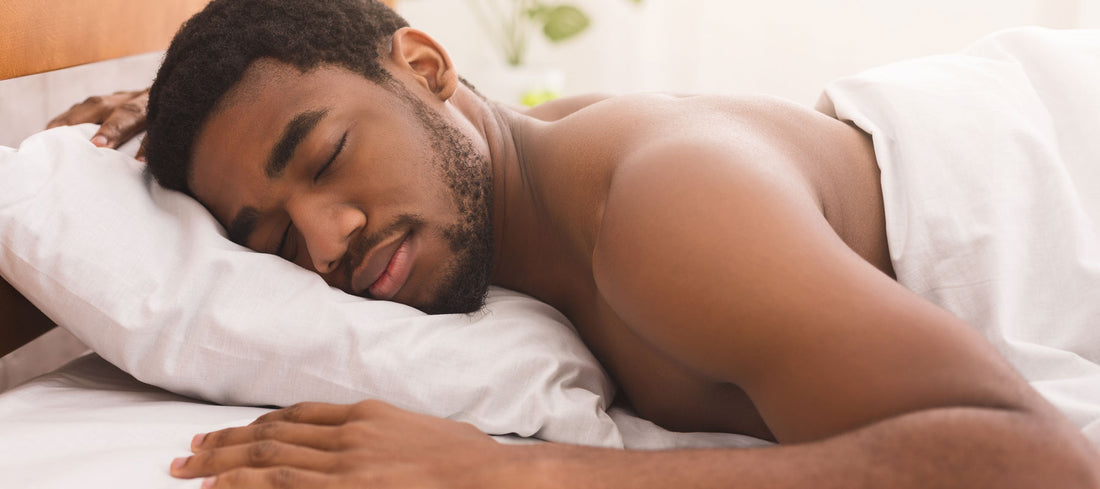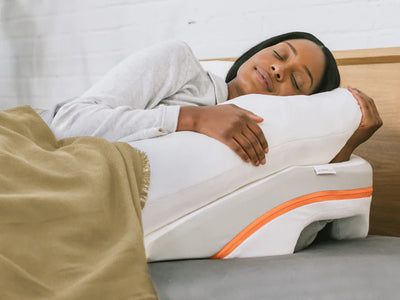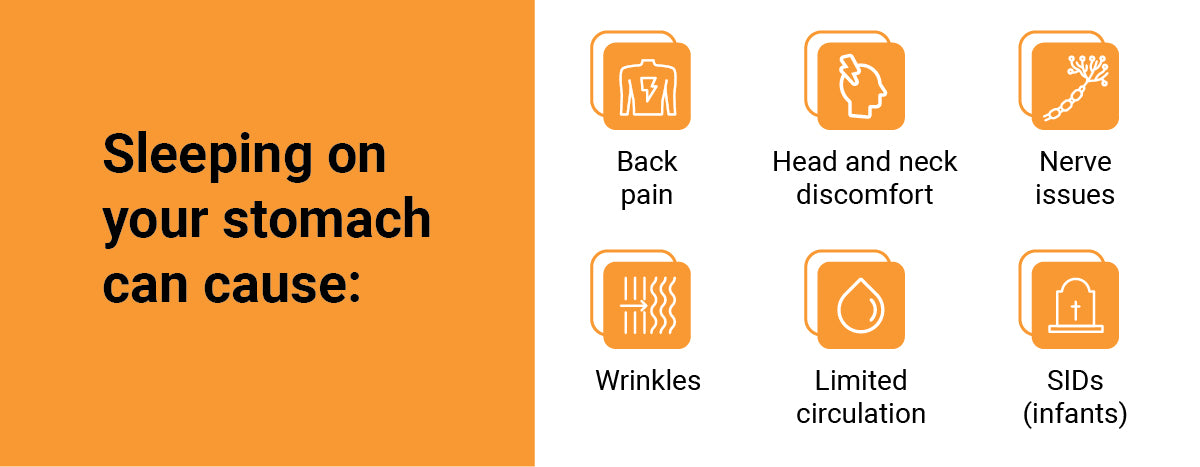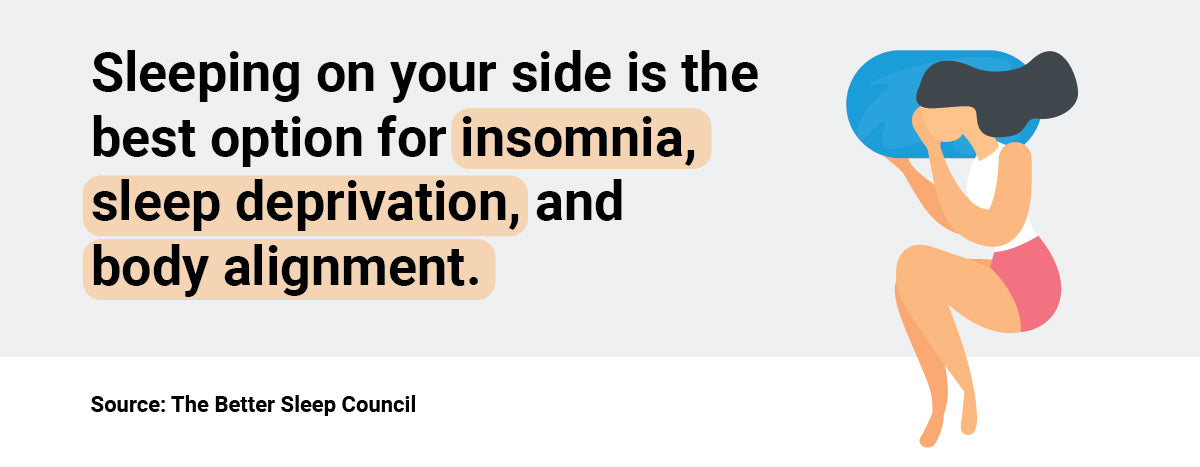
Related Product

Reflux Relief System
$249.99 USD
Say goodbye to nighttime Acid Reflux & GERD pain without sacrificing comfort.
Is It Bad to Sleep on Your Stomach?
Share
In most cases, yes. Although sleeping on your stomach might feel comfortable in the moment — and mitigate snoring and sleep apnea symptoms — it can also contribute to back and neck pain, leaving you feeling the residual effects for days. What’s more, stomach-sleeping can be especially harmful for moms-to-be and newborns.
Whether you’re on a mission to find the most beneficial sleeping position for your health or are just looking for tips for stomach-sleepers, you’re in the right place. In this post, we’ll be discussing whether it’s bad to sleep on your stomach, list off some pros and cons, and offer up some stomach-sleeping tips to help you optimize your preferred sleeping posture.
- Reasons Why it’s Bad to Sleep on Your Stomach
- Are There Any Positives to Sleeping on Your Stomach?
- Tips for Sleeping on Your Stomach
- End Nighttime Pain With a MedCline Relief System
Reasons Why it’s Bad to Sleep on Your Stomach

Sleeping on your stomach can cause:
- Back pain
- Head and neck discomfort
- Nerve issues
- Wrinkles
- Limited circulation
- SIDs (infants)
In most cases, sleep experts 1 agree that sleeping on your stomach is a bad call. When you sleep on your stomach, it’s harder to keep your spine in a neutral position, which can, in turn, strain your spine and cause back and neck pain. However, the trouble with stomach-sleeping doesn’t stop there — below, you’ll find a list of the potentially negative effects this sleeping posture can have on your body in both the short and long term.
For everyone
Whether you’re old, young, or somewhere in between, sleeping on your stomach can come with some serious consequences.
Main issues: back and neck pain, wrinkles
While 7% of adults choose to sleep on their stomach 1 , there are several reasons why the stomach-sleeping position is problematic for most individuals, regardless of age or lifestyle. One of the most prominent issues with sleeping on your stomach is the appearance of back and neck pain.

When you sleep on your stomach, not only is your spine curved in a precarious position, but your head is likely turned to one side for a long period of time throughout the night. According to the Cleveland Health Clinic 2 , this position ends up straining the muscles in your neck, resulting in soreness and pain the following day. The clinic also says that as your neck extends backward, your spine becomes compressed, which can limit blood flow, constrict nerves, and cause your arm to fall asleep at night.
Additionally, because the spinal cord houses so many nerves, a small tweak or pinched nerve can cause major issues that can impact your sleep quality and nervous system.
On top of nerve issues and neck and back pressure, stomach-sleeping can also have some cosmetic implications as well. When you sleep on your stomach with your head to one side or the other, pressure is applied to that side of your face for hours at a time, causing your skin to bunch and wrinkle over time. Younger individuals don’t tend to see the effects so much thanks to higher levels of collagen in their skin, but years of stomach-sleeping could cause permanent wrinkles. The National Sleep Foundation 3 says back-sleeping is generally considered the best option for those who want to avoid getting wrinkles while they sleep.
For pregnant women
Finding the right sleeping position while you’re pregnant can be a challenge in and of itself, but sleeping on your stomach may not be the solution to a good night’s rest.
Main issues: uncomfortable in third trimester, stomach pain, limited circulation
While stomach-sleeping is considered safe early on in a pregnancy 4, as the stomach continues to grow, it eventually becomes uncomfortable or impossible to do at all. In addition to general discomfort, sleeping on your stomach while you’re pregnant can cause targeted back and stomach pain. Because of the extra weight they’re carrying, many pregnant women already experience back pain as part of their pregnancy; when combined with a non-neutral spine while sleeping, back pain can become exacerbated.
According to Stanford Children’s Health 4, the best sleeping position for pregnant women is on their side because it promotes optimal blood flow to the fetus and heart, and puts less pressure on the back. A pregnancy pillow may help with adjusting to side-sleeping.
For babies
For the first few months of their life, infants will need to be positioned in their crib when they sleep until they’re able to shift postures on their own. Because it puts them at a higher risk for sudden infant death syndrome (SIDS), stomach-sleeping is not recommended 5 for infants. Newborns should be placed flat on their back 6 on a firm surface to sleep.
Main issues: SIDs (Sudden Infant Death Syndrome)

When is it Okay to Sleep on Your Stomach?
Now that we’ve answered the question at hand — is it bad to sleep on your stomach — you’re probably wondering if there are any positive aspects of stomach-sleeping. According to the National Sleep Foundation 1, the only real plus side is that sleeping on your stomach or side can help ease snoring.
Tips for Sleeping on Your Stomach
If sleeping on your stomach is non-negotiable, take a look at these tips for stomach-sleepers to learn about the best ways to align your body, position your pillow, and more.
- Use a thin pillow to minimize the angle between your head/neck and the rest of your body.
- Stretch before and after bed to improve body alignment, alleviate pain, and strengthen muscles.
- Place a body pillow under your pelvis to help neutralize your spine.
- Focus on body alignment as you start to fall asleep to make sure your body is well-positioned before bed.
- Put a pillow underneath your forehead to open your airways without having to turn your head to one side, straining your neck.
- Try to keep both legs flat and at equal heights — lifting one leg can cause you to twist your spine and result in additional back pain.
End Nighttime Pain With a MedCline Relief System
To review: sleeping on your stomach can cause head, back, neck, and nerve pain due to the added pressure and positioning of the spine. While stomach-sleeping can help relieve snoring and sleep apnea symptoms, sleep experts warn 7 that the negative effects of the posture tend to outweigh these benefits.
So, what’s the safest position to snooze? According to The Better Sleep Council 7, sleeping on your side is the best option for insomnia, sleep deprivation, and body alignment. What’s more, side-sleeping also prevents acid reflux, which affects 1 in 5 Americans 8 and is very common in the third trimester.

If you’re having trouble getting comfortable on your side due to shoulder pain or awkward arm positioning, learn how one of our Relief Systems can help. Now that you know more about the problematic effects of stomach-sleeping and sleeping postures in general let’s take a look at how MedCline pillows work.
MedCline Shoulder Relief System
Our Shoulder Relief System is designed to create the optimal side-sleeping experience, free of shoulder pain. With a patented arm pocket and elevated construction, our shoulder relief pillow allows your arm to comfortably rest beneath your head without applying the pressure that strains your neck and shoulders.
Key features of MedCline Shoulder Relief System:
MedCline Acid Reflux Relief System
If you suffer from acid reflux like so many others do, our Acid Reflux Relief System is fully equipped to provide you with the nighttime acid reflux relief you need. Our patented three-part system has been clinically proven to improve symptoms of Gastroesophageal Reflux Disease (GERD) // Acid Reflux, Laryngopharyngeal Reflux (LPR) // Silent Reflux, and Gestational Reflux. Constructed with medical-grade materials and physician recommendations, our Acid Reflux Relief System is better than a wedge pillow and offers long-term relief from acid reflux.
Searching for the right position and pillow for your needs? Try a MedCline Relief System — our Sleep Specialists will help you tailor the product and your position to achieve those high-quality zzz’s you’ve been yearning for.
References
- “The Best Sleep Position for Your Body,” The National Sleep Foundation, https://thesleepdoctor.com/sleep-hygiene/best-sleeping-position/, 31 Jul. 2020
- “Back, Side, or Stomach: Which Sleep Position is Best for You?”, Cleveland Health Clinic, https://health.clevelandclinic.org/back-side-stomach-sleep-position-best/, 31 Jul. 2020
- “Wrinkles From Sleep?”, National Sleep Foundation, https://thesleepdoctor.com/physical-health/lack-of-sleep-and-acne/, 31 Jul. 2020
- “Sleeping Positions During Pregnancy”, Stanford Children’s Health, https://www.stanfordchildrens.org/en/topic/default?id=sleeping-positions-during-pregnancy-85-P01238, 31 Jul. 2020
- “Known Risk Factors for SIDS and Other Sleep-Related Causes of Infant Death”, National Institute of Child Health and Human Development, https://safetosleep.nichd.nih.gov/safesleepbasics/risk/factors, 31 Jul. 2020
- “Sleep and Your Newborn”, Kids Health, From Nemours, https://kidshealth.org/en/parents/sleepnewborn.html, 31 Jul. 2020
- “Starfish or Freefall? What Your Sleep Position Can Tell You”, The Better Sleep Council, https://bettersleep.org/better-sleep/sleep-positions/, 31 Jul. 2020
- “Introduction to GERD”, International Foundation for Gastrointestinal Disorders, https://aboutgerd.org/what-is/introduction-to-gerd/#:~:text=Gastroesophageal%20reflux%20disease%2C%20or%20GERD,It%20also%20occurs%20in%20children., 31 Jul. 2020
Related Product

Reflux Relief System
$249.99 USD
Say goodbye to nighttime Acid Reflux & GERD pain without sacrificing comfort.


